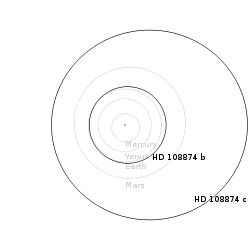Astronomy:HD 108874
| Observation data Equinox J2000.0]] (ICRS) | |
|---|---|
| Constellation | Coma Berenices[1] |
| Right ascension | 12h 30m 26.882s[2] |
| Declination | +22° 52′ 47.38″[2] |
| Apparent magnitude (V) | 8.76[1] |
| Characteristics | |
| Spectral type | G5 V[3] or G9 V[4] |
| B−V color index | 0.738±0.018[1] |
| Astrometry | |
| Radial velocity (Rv) | −30.052±0.0028[5] km/s |
| Proper motion (μ) | RA: 127.469[2] mas/yr Dec.: −89.912[2] mas/yr |
| Parallax (π) | 16.7730 ± 0.0443[2] mas |
| Distance | 194.5 ± 0.5 ly (59.6 ± 0.2 pc) |
| Absolute magnitude (MV) | 4.79[1] |
| Details | |
| Mass | 0.996±0.032[6] M☉ |
| Radius | 1.062±0.070[6] R☉ |
| Luminosity | 1.19[1] L☉ |
| Surface gravity (log g) | 4.39±[6] cgs |
| Temperature | 5,585±20[6] K |
| Metallicity [Fe/H] | 0.18[3] dex |
| Rotation | 40.20±0.15 days[6] |
| Rotational velocity (v sin i) | 1.36±0.26[6] km/s |
| Age | 6.48±3.47[6] Gyr |
| Other designations | |
| Database references | |
| SIMBAD | data |
| Exoplanet Archive | data |
HD 108874 is a star with a pair of orbiting exoplanets in the northern constellation of Coma Berenices. It is located 194.5 light years from the Sun based on parallax measurements, but is drifting closer with a radial velocity of −30 km/s.[5] The absolute magnitude of this star is 4.79,[1] but at that distance the star has an apparent visual magnitude of 8.76,[1] making it too faint to be visible to the naked eye. HD 108874 has a relatively large proper motion, traversing the celestial sphere at an angular rate of 0.157″ yr−1.[8]
The spectrum of HD 108874 presents as a G-type main-sequence star with a stellar classification of G5 V.[3] (An alternate source gives a class of G9 V.)[4] It is probably billions of years older than the Sun although the age is not well constrained. The level of magnetic activity in the chromosphere is lower than in the Sun and it is spinning with a low rotation period of 40 days.[6] The star has about the same mass as the Sun, but the radius is 6% larger. The abundance of iron, an indicator of the star's metallicity, is 1.18 times that of the Sun.[6][3] The star is radiating 1.19[1] times the luminosity of the Sun from its photosphere at an effective temperature of about 5600 K.[6]
Planetary system
In 2003, the jovian planet HD 108874 b was discovered by the US-based team led by Paul Butler, Geoffrey Marcy, Steven Vogt, and Debra Fischer. A total of 20 radial velocity observations, obtained at the W. M. Keck Observatory between 1999 and 2002, were used to make the discovery.[9] In 2005, further observations revealed this star has another jovian planet orbiting further out, designated as HD 108874 c.[3] The orbital parameters of both planets were updated in 2009 with additional observations.[10] There is an additional radial velocity signal in the data at a period of 40 days however this likely caused by the stellar rotation period.[6]
Those two planets are near, and possibly in a 9:2 orbital resonance. This means if HD 108874 b orbits the star nine times, then HD 108874 c orbits twice, because the orbital period for planet c is four and a half times longer than planet b.[6]
| Companion (in order from star) |
Mass | Semimajor axis (AU) |
Orbital period (days) |
Eccentricity | Inclination | Radius |
|---|---|---|---|---|---|---|
| b | >1.25±0.10 MJ | 1.05±0.02 | 395.34±0.19 | 0.142±0.011 | — | — |
| c | >1.09±0.16 MJ | 2.81±0.06 | 1732.2±9.8 | 0.229±0.032 | — | — |
See also
- List of extrasolar planets
References
- ↑ 1.0 1.1 1.2 1.3 1.4 1.5 1.6 1.7 Anderson, E.; Francis, Ch. (2012). "XHIP: An extended hipparcos compilation". Astronomy Letters 38 (5): 331. doi:10.1134/S1063773712050015. Bibcode: 2012AstL...38..331A.
- ↑ 2.0 2.1 2.2 2.3 Vallenari, A. et al. (2022). "Gaia Data Release 3. Summary of the content and survey properties". Astronomy & Astrophysics. doi:10.1051/0004-6361/202243940 Gaia DR3 record for this source at VizieR.
- ↑ 3.0 3.1 3.2 3.3 3.4 Vogt, Steven S. et al. (2005). "Five New Multicomponent Planetary Systems". The Astrophysical Journal 632 (1): 638–658. doi:10.1086/432901. Bibcode: 2005ApJ...632..638V.
- ↑ 4.0 4.1 Yoss, K. M.; Griffin, R. F. (September 1997). "Radial Velocities and DDO, BV Photometry of Henry Draper G5-M Stars Near the North Galactic Pole". Journal of Astrophysics and Astronomy 18 (2–3): 161. doi:10.1007/BF02714877. Bibcode: 1997JApA...18..161Y.
- ↑ 5.0 5.1 Soubiran, C. et al. (2018). "Gaia Data Release 2. The catalogue of radial velocity standard stars". Astronomy and Astrophysics 616: A7. doi:10.1051/0004-6361/201832795. Bibcode: 2018A&A...616A...7S.
- ↑ 6.00 6.01 6.02 6.03 6.04 6.05 6.06 6.07 6.08 6.09 6.10 6.11 6.12 Benatti, S. et al. (2017). "The GAPS Programme with HARPS-N at TNG. XII. Characterization of the planetary system around HD 108874". Astronomy and Astrophysics 599: A90. doi:10.1051/0004-6361/201629484. Bibcode: 2017A&A...599A..90B.
- ↑ "HD 108874". SIMBAD. Centre de données astronomiques de Strasbourg. http://simbad.u-strasbg.fr/simbad/sim-basic?Ident=HD+108874.
- ↑ Lépine, Sébastien; Shara, Michael M. (March 2005). "A Catalog of Northern Stars with Annual Proper Motions Larger than 0.15" (LSPM-NORTH Catalog)". The Astronomical Journal 129 (3): 1483–1522. doi:10.1086/427854. Bibcode: 2005AJ....129.1483L.
- ↑ Butler, R. Paul et al. (2003). "Seven New Keck Planets Orbiting G and K Dwarfs". The Astrophysical Journal 582 (1): 455–466. doi:10.1086/344570. Bibcode: 2003ApJ...582..455B.
- ↑ Wright, J. T. et al. (2009). "Ten New and Updated Multi-planet Systems, and a Survey of Exoplanetary Systems". The Astrophysical Journal 693 (2): 1084–1099. doi:10.1088/0004-637X/693/2/1084. Bibcode: 2009ApJ...693.1084W.
External links
- Extrasolar Planet Interactions by Rory Barnes & Richard Greenberg, Lunar and Planetary Lab, University of Arizona
Coordinates: ![]() 12h 30m 26.8829s, +22° 52′ 47.383″
12h 30m 26.8829s, +22° 52′ 47.383″
 |


